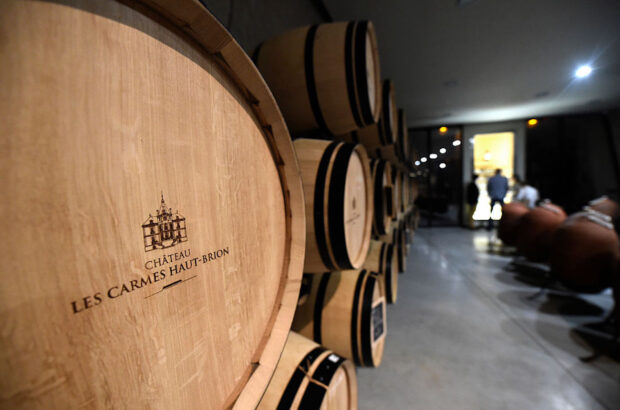If your wine cork crumbles, or even breaks, try not to stress. You could try filtering the wine using a thin cloth and funnel. For old or fragile wines, pour carefully and consider filtering directly into the glass. A crumbled cork doesn’t necessarily mean the wine is faulty, but it might indicate improper storage. There is no foolproof way to avoid breaking corks, but using a two-prong opener (butler’s thief) is recommended for older wines. If the cork breaks inside the bottle, try pushing it in and using a spoon handle while pouring.
If you open enough bottles of older wine, it’s bound to happen to you. While opening a special bottle of wine, you remove the corkscrew only to find bits of cork attached. Staring down into the bottleneck you see the bulk of it remains, despite your best efforts.
The worries are twofold: saving face as one battles with the obvious lack of expertise and, most importantly, preserving the precious wine. Can it still be drunk after a cork disaster?
We’ve asked an expert for techniques and coping strategies. Alexandre Freguin’s first piece of advice is clear: ‘Do not stress. This will only make it worse.’ Freguin, UK Best Sommelier 2018, former head sommelier at Chez Bruce and Famille Perrin brand ambassador, has had to deal with his share of tricky corks.
The most important strategy, particularly in one of the world’s top restaurants, is keeping one’s cool.
The cork has crumbled. Now what?
The simplest and most obvious solution is to find a way to filter the wine.
‘Clearing the wine from the floating bits of cork is the goal,’ says Freguin. ‘I find that a very thin cloth is particularly useful and works well. Cover a funnel with the cloth and pour the wine into another container, such as a decanter.’
But it’s important that you handle the wine delicately.
‘Be careful. If we are talking about an old and probably fragile wine, I wouldn’t pour the entire bottle out, only until the pieces of cork have fallen on the cloth. Then gently pour the wine back into the bottle.’ The filtration and additional aeration will speed up the process of oxidation and the loss of the more volatile aromas. This has a negative impact on a particularly delicate wine. You might even want to consider, in such cases, filtering directly into the glass.
DWWA results out 19 June!
Be the first to know: Subscribe to the DWWA newsletter
If the cork has crumbled, does it mean the wine is faulty?
If a wine has been properly stored horizontally, with liquid in contact with the cork’s inner surface and in a space with enough humidity, the cork should remain hydrated and in good condition. A hydrated cork will keep its flexibility and structure. If the bottles are stored vertically for too long in dry conditions, the cork will soon dry out. It can become brittle and lose its cohesion.
‘Corks can be tricky, especially on older bottles, but they are also a great source of information about the state of conservation and storage of the wine. I will have questions about how the wine was cellared if the cork just falls apart,’ says Freguin.
It might mean that the wine has had unwanted contact with oxygen, possibly for a long time, and is, therefore not in an optimum condition. So, taste carefully before serving the wine to guests. But a crumbling cork does not necessarily mean that the wine’s quality has been compromised.
‘Some of the best bottles of wine I have tasted have had the worst cork condition,’ says Clement Robert MS, director of wine and spirits at Liquid Icons. In most cases the wine will still be fine to drink, as it should still have been kept with a protective seal.
One thing to keep in mind, this does not mean the wine is corked.
‘One of the most common misconceptions is that the small bits of deteriorated cork in contact with the wine will make it ‘corked.’ But you can rest easy, that’s not the case,’ says Robert.
Cork taint is not a product of cork itself; it happens due to the presence of a chemical compound (TCA), which can occur in any cork, old or new, dry or moist. If it isn’t there to begin with, then it won’t be there when the cork breaks.
Is there a foolproof way to avoid breaking corks?
The quick answer is no. You might have the best corkscrew on the market, and you might have done it a million times before. Corks crumble and break even at the hands of the most experienced sommeliers. This is especially true for old bottles which have not been stored correctly, leaving the cork dry and crumbly.
Sommeliers recommend having a two-prong opener, also known as butler’s thief, on hand and using it on older wines or if the cork looks like it may be prone to breaking.
The butler’s thief is essentially a handle with two flat metal prongs attached. They are sprung so that when you work them (cautiously) down the sides of a cork that looks/feels like it may crumble, they apply some inward pressure to the potentially dodgy cork.
Once you’ve persuaded the prongs far enough down between the cork and the inner side of the bottleneck – start with the longer of the two and use a slight lateral motion as you progress rather than pressing directly down – that pressure enables you to begin pulling up while rotating the cork out of the bottleneck.
You might even want to consider using the two-prong opener and a corkscrew simultaneously. The latter’s spiral creates more inner pressure against the prongs, allowing the cork to remain more compact while being pulled by the prongs. There is a new product on the market called the Durand, which combines these two traditional wine openers.
The cork has broken… Now what?
Suppose you don’t have an alternative tool, and you’re stuck with a broken cork. In that case, half of it still blocks the bottleneck, meaning you can’t even filter the wine. You have two options: continue trying with your corkscrew, inserting it carefully and pulling the cork in one go instead of twisting, or simply concede and push the cork down into the bottle.
If this happens, remember to use the handle of a teaspoon to keep the cork down while pouring to prevent wine from spurting. It’s not the most elegant solution, but it serves the ultimate purpose: drinking the wine.







